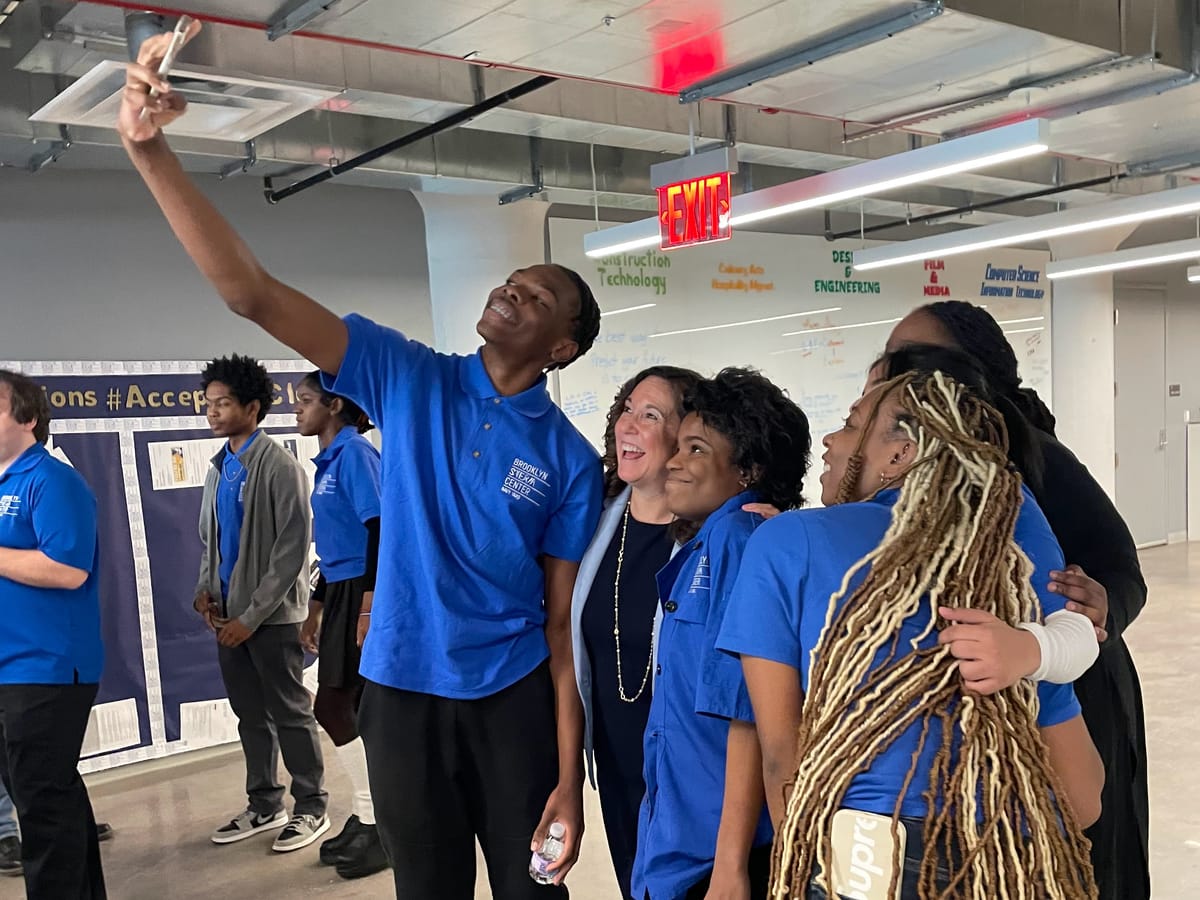Deputy Secretary of Education Visits Brooklyn STEAM Center For Its Magic Formula
"A deep sense of belonging and well-being in a very rich academic environment that leads to well-paying jobs and careers that make a difference in the community. That's the magic formula," Marten says. "And we want to see that replicated everywhere."

The Brooklyn STEAM Center hosted the U.S. Deputy Secretary of Education Cindy Marten Wednesday morning, offering her a glimpse of what can be done when education and industry leaders work together to develop the kind of vocational training – also known as Career Technical Education (CTE) – that quickly leads to well-paying jobs for high school graduates.
Since 2019, the Brooklyn STEAM Center (STEAM stands for Science, Technology, Engineering, Arts & Math) has occupied the third floor of the Navy Yard's Building 77. It brings over 400 high school juniors and seniors from eight local high schools interested in pursuing careers in cybersecurity, full-stack development, construction technology, culinary arts, hospitality management, design & engineering, and film & media (a list that is ever-increasing) onto a campus filled with tenants specializing in these industries.
Marten was visiting the Brooklyn STEAM Center as part of her "Raise the Bar: Lead the World" tour to learn from the best examples across the country of what it takes to "unlock career success." While President Biden did not linger on his education agenda in the State of the Union address, the deputy secretary emphasized the focus on connecting students to career opportunities: "We can use ARP dollars and all of the investments from the CHIPS and Science act, infrastructure money to make that happen."
The Brooklyn STEAM Center "is a jewel, not just for New York, but really for the country," Marten told Bklyner after the visit at the Center, meeting it's
Founding Principal Kayon Pryce, education and industry partners, students, teachers and parents.

"I was looking at places that are "very much place-based, community based, where you're bringing together multiple partners, you've got business and industry, and education leaders coming together to design something actually meaningful for the community," Marten said. "The Brooklyn STEAM Center – if you want to check all the boxes, they have it here."
Another reason for the visit to the Brooklyn STEAM Center was that the Biden administration is looking for replicability as well as excellence.
"I think there's a formula here that includes the four key areas of unlocking career success. Anyone that wants to replicate this in the country they have to localize it with their local business and industry needs like the Brooklyn STEAM center has done here, but it has the four parts: it has work-based learning clearly in place, it has career navigation tools for students to find their ways into meaningful careers, making $50,000 a year while they're still in high school, for example," Marten said.
"The third part is their industry-sought credentials. They've built something here where kids are getting the kinds of credentials that the industry actually needs right now. And the fourth part is they have dual enrollment options. So kids are getting college credits and ready to have their pathway for college and career technical education to become contributing members of the community into the industries that are needing the workforce right now."

Does that mean not everyone needs to go to college?
"We can redesign our education and workforce systems to be on-ramps for our young people to find their way into rewarding careers," Marten says, adding that it is not an either-or proposition.
"Most good jobs that provide a living wage require some form of career connected, post-secondary education, and training. And it can be a holistic approach. Here they're partnering with the eight feeder high schools. They [students] are getting their education at the feeder high school, and then they come here and get the work-based learning. They're getting paid internships and real job experiences, life skills, soft skills, and hard skills that are needed to have full careers and be contributing members of their communities."
The most surprising thing about the visit? "To see in action, what's possible," Marten said. "The scale of design and the speed in which they're able to move things."
Marten credits the Center's leadership and its intentional collaboration of business and industry partners with educators, fostering a sense of belonging, and leveraging federal, state, and local dollars to make it all happen.
"A deep sense of belonging and well-being in a very rich academic environment that leads to well-paying jobs and careers that make a difference in the community. That's the magic formula," Marten says. "And we want to see that replicated everywhere."





